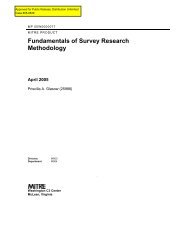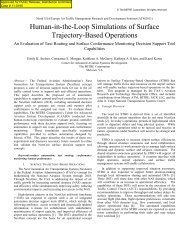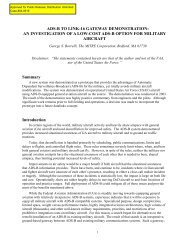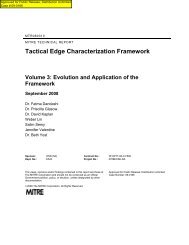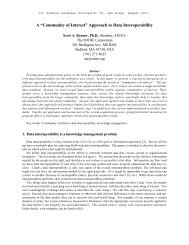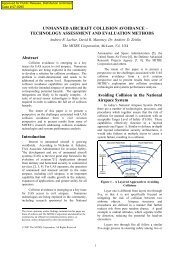A Predictive Model of User Equipage Costs for Future Air ... - Mitre
A Predictive Model of User Equipage Costs for Future Air ... - Mitre
A Predictive Model of User Equipage Costs for Future Air ... - Mitre
You also want an ePaper? Increase the reach of your titles
YUMPU automatically turns print PDFs into web optimized ePapers that Google loves.
9 Implementation Plans Defined<br />
The user responses and the associated costs described in Chapter 8 assumed voluntary equipage<br />
actions on the part <strong>of</strong> operators and manufacturers. In several <strong>of</strong> those cases, aircraft will exist that<br />
do not have CDTI capability. Since many CDTI operational procedures require 100% equipage to<br />
achieve the expected benefits, it may be necessary to mandate compliance within a specific<br />
timeframe. An Implementation Plan defines a specific timeframe <strong>of</strong> implementation that can be<br />
applied to all <strong>of</strong> the user responses to determine the range <strong>of</strong> non-compliant aircraft and their<br />
associated costs <strong>of</strong> compliance. This provides <strong>for</strong> two different <strong>for</strong>ms <strong>of</strong> cost accounting with<br />
respect to the costs attributable to the program; voluntary costs and involuntary costs.<br />
Voluntary costs are defined within the implementation plan as the costs a user will assume on a<br />
voluntary basis. These are costs that a user would spend without any <strong>for</strong>cing event to equip with<br />
the desired avionics. The voluntary costs are not accounted against the program and are there<strong>for</strong>e<br />
considered borne by the user as the user has determined that these costs are justified <strong>for</strong> the<br />
benefits received by having the capability on the aircraft. These costs occur prior to the issuance<br />
<strong>of</strong> a mandate.<br />
Any costs incurred after the identification <strong>of</strong> a mandate, or access denial if not equipped with the<br />
desired technology, are considered to be involuntary costs. These costs are all considered to be<br />
against any benefits defined <strong>for</strong> the system. The total equipage costs are the sum <strong>of</strong> the voluntary<br />
and involuntary costs accumulated to achieve the equipage.<br />
9.1 Implementation Plan #1 (IP1)<br />
Spiral 3 <strong>of</strong> the FAA’s plan is scheduled to end in December 2016, resulting in full provision <strong>of</strong><br />
ADS-B services. There<strong>for</strong>e, it was desired to investigate a mandate that would begin in January<br />
2017 in order to achieve 100% equipage <strong>of</strong> the affected U.S. fleet by December 2020. This would<br />
allow <strong>for</strong> full use <strong>of</strong> CDTI procedures in 2021 above FL 100, in Class B airspace, and at the top<br />
~70 airports. It was estimated that 10% <strong>of</strong> the GA aircraft would not need to meet this criteria and<br />
would thus not be required to equip.<br />
This timing was applied to each <strong>of</strong> the possible user responses described in Chapter 8. Any<br />
aircraft that was equipped prior to 2017 was considered to be a “voluntary” equipage, as there was<br />
no <strong>for</strong>ced equipage requirement at that time. <strong>Air</strong>craft that needed to be modified after 2016 were<br />
considered to be <strong>for</strong>ced into compliance, whether or not the user would have done so voluntarily<br />
anyway, since they are subject to the mandate and should be captured as a cost <strong>of</strong> the mandate.<br />
These aircraft are referred to as “stragglers” since they did not voluntarily equip prior to the<br />
mandate.<br />
This Implementation Plan timing was analyzed <strong>for</strong> two types <strong>of</strong> rules; required broadcast only<br />
capability, and required CDTI capability.<br />
9-1



